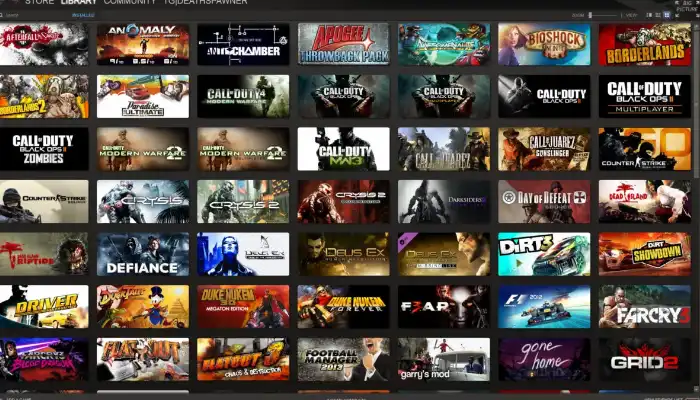Valve Corporation is renowned for games such as Half-Life and Portal which have continued to redefine the online gaming experience. An instance of this is Steam Family Sharing, which allows users to share their Steam game libraries with authorized accounts. This article explores Steam Family Sharing, its functionalities, limitations, and how it can change families’ experiences with playing games.

Understanding Steam Family Sharing
Steam Family Sharing makes it possible for people to link trusted accounts on specific computers, referred to as “authorized devices.” Authorized accounts are then able to access and play any game in the primary account’s library if the primary account is not actively playing the same game. It creates a sense of community among family members or friends who enjoy gaming together because they have a chance to play different games without making individual purchases.
Sharing games on Steam has been an account owner sharing his or her login details with another person who would want to play something they do not own. This was deemed insecure and contrary to Steam’s rules. It removes these risks associated with sharing credentials and provides more seamless gaming experiences for all parties involved.
Here are some of the advantages of Steam Family Sharing:
- Affordable gaming: In fact, families or friends can avail themselves of more options without having to buy separately, which is particularly helpful when one wants first-hand experience before buying a full version of the game.
- Ease-of-accessibility: Authenticated users may access this shared library from any approved device, thereby enhancing flexibility.
- Shared fun: With it, there is a connection between gamers as well as families who join hands in exploring and enjoying video games together, thus making interactive tasks easier.
Setting Up Steam Family Sharing: A Step-by-Step Guide
Willing to unlock your potential in Steam family sharing? Here are some simple steps worth trying:
- Enable Steam Guard: Make sure that your main account has already activated Steam Guard for additional security concerns. Go to “Steam” -> “Settings” -> “Account” to find this option.
- Authorize a Device: To start with, open the Steam software on your computer you wish to permit; log onto your main account; and go to “Steam” in the top menu bar. Click “Settings,” then “Family.” Underneath ‘Family Library Sharing’, tick “Authorize Library Sharing on this device.”
- Choose Accounts to Share With: A list of accounts that have logged into this computer will appear. Choose the accounts you would like to give permission for them to take part in game sharing and press “Ok.”.
As such, authorized accounts can log in with their Steam accounts using an authorized device and access the shared gaming library.
Sharing with Limitations: Important Considerations
While Steam Family Sharing provides a wide range of benefits, there are important things one should know concerning its limitations:
- Simultaneous Play Restrictions: Only one authorized account can play from a shared library at any given time. In case an authorized user is accessing a particular game already being played by the primary owner, he or she receives a notification, after which they are disconnected within a few seconds of the grace period.
- Not All Games Supported: There are some games whose developers or publishers have decided not to share via Steam Family Sharing, and it is simply indicated by this phrase when one tries sharing such games.
- Content and DLC Limitations: Typically, free-to-play games and downloadable content (DLC) are not available for sharing through Steam Family Sharing. Authorized users may have to purchase these items independently to access them.
The users of this software should be aware of these limitations to ensure that the whole experience is smooth and fun in the Steam family sharing.
Enhanced Connections, Amplified Fun: The Perks of Steam Family Sharing
There are several advantages associated with Steam family sharing, which makes it a useful tool for gamers:
- Strengthening Family Bonds: Gaming can be an awesome way of bonding within families. This financial obstacle has been removed by steam family sharing, thereby allowing parents and children, siblings, or even cousins to explore and enjoy games together. Just think about a co-op title where you conquered a tough boss or built up a thriving civilization in a strategy game. These shared experiences can create lasting memories and strengthen family bonds.
- Cost-Effectiveness for Budget-Conscious Gamers: Building an extensive range of games can be very expensive. Within the household, any single purchase made can be used by multiple members. This is good news for families or groups of friends because they all get access to more games without necessarily having to spend too much money on them.
- Expanding Gaming Horizons: Through Steam family sharing, one can experience new genres and different gaming platforms. By testing out your sibling’s library before actually purchasing a game, you can discover hidden gems or gaming experiences you never knew existed. This can lead you down exciting paths in the gaming world, opening your mind to new possibilities.
Sharing with Limits: Considerations for Steam Family Sharing
Despite its numerous pros, there are some limitations that come with steam family sharing.
- Restricted Device Sharing: A single authorized device is allowed streaming rights from only one library at a time; therefore, other authorized users cannot access the same game if the primary account holder is already playing it.
- Concurrent Gameplay Hurdles: A few games can be played offline with Steam family sharing, but others require an online primary account to access them on authorized devices. This may not work well when several users want to play different games at once.
- Library Management and Ownership Concerns: When you share a game library, things become complicated. The main account’s library cannot be edited or added to by authorized users. Moreover, primary account holders maintain ownership over the games, meaning that if there is any change in family relationships or authorization is taken away, then authorized users would lose access privileges.
The Community Weighs In: Reactions and the Road Ahead for Steam Family Sharing
Steam Family Sharing has received mixed reactions from the gaming community since its inception. Here is what people think about it:
- Initial Reactions: Many users welcomed Steam Family Sharing as a positive step towards fostering a more inclusive gaming environment, particularly for families. The cost-saving benefits and the opportunity to introduce younger generations to new genres were seen as major advantages.
- Common Concerns and Criticisms: Several gamers expressed concern about concurrent gameplay restrictions and device sharing limits, while others feared that their libraries were vulnerable to being trespassed into or misused without their permission.
- Valve is responding to this and its plans: Steam developers, Valve, have responded to these concerns and are still fine-tuning the Steam Family Sharing system. Nonetheless, there have been no big announcements about changes in concurrent gameplay limitations, but what it shows is that Valve is still committed to making the user experience better.
Sharing the Fun: A Guide to Maximizing Steam Family Sharing
Steam Family Sharing provides you with the opportunity to spread out your huge Steam library to particular accounts, thus creating a world of cooperative gaming experiences or single players within your home. But remember, with great power comes great responsibility! To optimize Steam Family Sharing, it needs clear communication, responsible management, and an understanding of the platform’s policies. This guide arms you with tips on how to navigate Steam Family Sharing like a pro, ensuring that everyone has a seamless ride during their gaming experience on this system.
Understanding the Benefits of Steam Family Sharing
- Shared Game Libraries: Enable others who are approved by you to be able to explore a wide range of titles from your vast collection without necessarily having bought them individually.
- Cooperative Play: Team up with family members for thrilling co-op adventures in games that support it. Imagine conquering campaigns or just battling online foes together!
- Individual Play: Your family members can play single-player games from your library on their own accounts, which encourages independent gaming experiences.
- Cost-Effectiveness: Do not buy duplicates within the house! Consequently, anyone can enjoy a wide variety of games without causing financial constraints.
Sharing Games Responsibly: Managing Authorized Devices
- Two Concurrent Authorized Devices: You can authorize your account on a maximum of two devices through Steam Family Sharing at any given time; this ensures fair play and prevents unauthorized access.
- Prioritizing Active Players: Even if another authorized device has been put into use already, owners will always get first dibs on games (yours). This ensures you are always playing your games so that you don’t get frustrated.
- Deauthorization: Need to revoke access from a particular device? Steam is designed with a simple way of removing authorization, allowing you to control authorized devices well.
Here’s an important thing: Make sure that the devices you have endorsed on Steam are at your fingertips. This will help in identifying and de-authorizing any foreign device if necessary.
Open Communication is Key: Talking to Family and Friends
- Setting Expectations: Discuss expectations with authorized users beforehand. This may involve setting up playtime schedules or specifying games that can or cannot be shared.
- Respecting Preferences: Everyone has their own gaming preferences. Encourage open communication about game choices to avoid conflicts or frustration.
- Maintaining Trust: In order for trust to grow within the Steam Family Sharing system, there must be transparency and clear communication.
Remember: It’s all about open discussions on expectations and preferences to make this feature useful for each player involved.
Staying Within the Guidelines: Steam Terms of Service
- Account Security: Never share your Steam account credentials with anyone, including authorized users. Sharing login information jeopardizes your account security and could lead to potential misuse.
- Commercial Use: The intended purpose for Steam Family Sharing is personal and non-commercial use within one household; game sharing for commercial purposes violates the terms of service of the Steam gaming platform.
- Accountability: Ultimately, the account owner (you) bears full responsibility for what happens on authorized devices. Keep in mind who you authorize and what they know about the terms of service.
Conclusion
Steam Family Sharing is a wonderful way to let your friends and family enjoy gaming. Effectively managing authorized devices, having an open line of communication with relatives and close friends, as well as adhering to Steam’s terms of service, will give you access to shared experiences that could not only unlock a world but also increase gains from this innovation. As the gaming landscape continues to evolve, Steam Family Sharing has the potential to further revolutionize how we approach game libraries and cooperative play within households.


